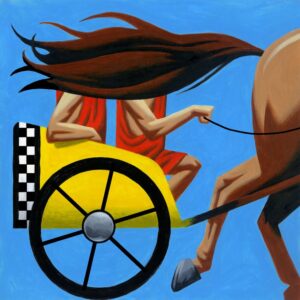Historically Speaking: When Taxis Were Drawn by Horses
Long before Uber, there were Roman litters, Venetian gondolas and other variations on the ride for hire.
March 10, 2023
Last month drivers working for Uber and Lyft went on strike in cities in the U.S., Great Britain and the Netherlands. This was on top of strikes in December. The digital ride-hailing companies are looking increasingly like the taxi industry of old: Customers complain about the prices while drivers say they are struggling financially.
Taxis have been a hallmark of urban life since ancient times. In Rome, the most ubiquitous taxi was the cisium, a two-wheeled horse-drawn carriage that could accommodate a single passenger plus a small amount of luggage. Customers could hail them from designated cisium ranks on the city’s main roads. In theory, drivers could be fined for speeding and other infractions, but they were very often a public nuisance. In the first century, the emperor Claudius went so far as to ban all for-hire wheeled vehicles from city centers, forcing travelers and those without private carriages to rely on independent litter-bearers and sedan chair porters.
During the Middle Ages, one of the first European cities to have strict regulations governing for-hire vehicles was Venice. In a city of canals, the vehicles in question were gondolas, and from at least the mid-14th century every gondolier had to belong to a guild, known as a scuola. Membership was relatively open and offered a way for immigrants to get ahead. A lawsuit between two scuolas in 1514 reveals that Giovanni the Ethiopian was one of the chief guild officers.
Other cities had battles over competition. In 1635, London’s watermen lobbied King Charles I to ban hackney carriage drivers from accepting journeys shorter than 3 miles. Neither this nor subsequent bans were well-enforced. In 1660, King Charles II prohibited hackney carriages from picking up fares in the streets, which, again, people ignored. On Nov. 22, 1660, the diarist Samuel Pepys wrote of hailing a coach after dinner and sending his wife home in it.

ILLUSTRATION: THOMAS FUCHS
The regulation of public carriage services in Paris and London is a tale of two very different approaches. Single horse-drawn cabriolets, from which the term “cab” derives, emerged in Paris in the 18th century, but the city saw them as a threat to traditional coachmen and so refused to license them. Customers complained that Paris coachmen were rude and unhelpful for want of competition.
London, for its part, frequently revised its licensing rules and coach regulations. Most important, it introduced the “knowledge” system, consisting of routes that every driver must able to recite to pass the license exam—a requirement that still exists today. A London taxi was, and is, expensive, but driving is a middle-class job, and the industry has largely avoided the labor strife that plagues New York.
Nor did London have the same terrible accident rates. In 1931, New York recorded more than 23,000 traffic accidents; incredibly, 21,000 of them involved a taxicab. Although the iconic Checker cabs provided more room for passengers and even helped to give New York its distinctive look until their production ended in 1982, taxi-driving was still regarded as a dangerous and low-status profession, exemplified by the introduction of the bulletproof partition in the 1990s.
The arrival of the new ride-hailing companies in 2009 disrupted the traditional taxi industry and forced cities to think about improving their systems. Now it is the turn of the disrupters to do the same.
